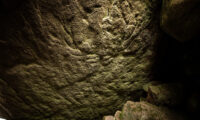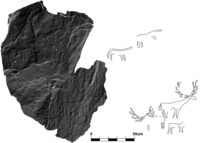 Rock art discovered inside Dunchraigaig Cairn in Kilmartin Glen, Argyll, are the first prehistoric animal carvings ever found in Scotland, and the earliest clearly identifiable carvings of deer ever found in the UK. Archaeologists estimate that they are between 4,000 and 5,000 years old, carved in the Neolithic or the Early Bronze Age.
Rock art discovered inside Dunchraigaig Cairn in Kilmartin Glen, Argyll, are the first prehistoric animal carvings ever found in Scotland, and the earliest clearly identifiable carvings of deer ever found in the UK. Archaeologists estimate that they are between 4,000 and 5,000 years old, carved in the Neolithic or the Early Bronze Age.
The rock art was discovered by amateur archaeologist Hamish Fenton. He was walking by Dunchraigaig Cairn and took a peek inside the third cist (one of three stone burial chambers in the cairn) with his flashlight. He noticed for the first time that there were carvings on the underside of the roof slab, and recognized one of them as a deer.
Fenton reported his find and experts from Scotland’s Rock Art Project and Historic Environment Scotland examined the carvings, using light scans and digital technology to create detailed 3D models of the cairn. They confirming the authenticity of the carvings.
 They depict two male red deer, recognizable from their large antlers and the short tail on one of the two. There are three other quadrupeds in the panel. There are no tell-tale antlers, but archaeologists believe two of the group of three may be juvenile deer.
They depict two male red deer, recognizable from their large antlers and the short tail on one of the two. There are three other quadrupeds in the panel. There are no tell-tale antlers, but archaeologists believe two of the group of three may be juvenile deer.
Kilmartin Glen has one of the most important concentration of Neolithic and Bronze Age remains in mainland Scotland, including some of the finest cup and ring markings in the country. This is the first time that animal carvings of this date have been discovered in an area with cup and ring markings in the UK.
There are over 3,000 prehistoric carved rocks in Scotland. The vast majority are cup and ring markings which are abstract motifs created by striking the rock surface with a stone tool, such as a large river-washed pebble. Most commonly, cup and ring markings are composed of a central cup mark surrounded by pecked concentric circles. While many of these mysterious carvings can still be seen in the open landscape today, we know little about how they were used, or what purpose they served.
Dr Tertia Barnett, Principal Investigator for Scotland’s Rock Art Project at HES, said: “It was previously thought that prehistoric animal carvings of this date didn’t exist in Scotland, although they are known in parts of Europe, so it is very exciting that they have now been discovered here for the first time in the historic Kilmartin Glen.”